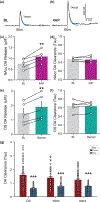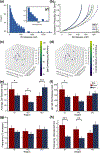Regional and sex differences in spontaneous striatal dopamine transmission
- PMID: 34265080
- PMCID: PMC10044475
- DOI: 10.1111/jnc.15473
Regional and sex differences in spontaneous striatal dopamine transmission
Abstract
Striatal dopamine release is key for learning and motivation and is composed of subregions including the dorsal striatum (DS), nucleus accumbens core, and the nucleus accumbens shell. Spontaneously occurring dopamine release was compared across these subregions. Dopamine release/uptake dynamics differ across striatal subregions, with dopamine transient release amplitude and release frequency greatest in male mice, and the largest signals observed in the DS. Surprisingly, female mice exhibited little regional differences in dopamine release for DS and nucleus accumbens core regions, but lower release in the nucleus accumbens shell. Blocking voltage-gated K+ channel (Kv channels) with 4-aminopyridine enhanced dopamine detection without affecting reuptake. The 4-aminopyridine effects were greatest in ventral regions of female mice, suggesting regional differences in Kv channel expression. The dopamine transporter blocker cocaine also enhanced detection across subregions in both sexes, with greater overall increased release in females than males. Thus, sex differences in dopamine transmission are apparent and likely include differences in the Kv channel and dopamine transporter function. The lack of regional differences in dopamine release observed in females indicates differential regulation of spontaneous and evoked dopamine release.
Keywords: Kv channels; accumbens; cocaine; dopamine; sex differences; striatum.
© 2021 International Society for Neurochemistry.
Conflict of interest statement
CONFLICT OF INTEREST
The authors declare no competing financial interests.
Figures







References
-
- Aragona BJ, Day JJ, Roitman MF, Cleaveland NA, Wightman RM, & Carelli RM (2009). Regional specificity in the real-time development of phasic dopamine transmission patterns during acquisition of a cue-cocaine association in rats. European Journal of Neuroscience, 30, 1889–1899. 10.1111/j.1460-9568.2009.07027.x - DOI - PMC - PubMed
Publication types
MeSH terms
Substances
Grants and funding
- P50 AA026117/AA/NIAAA NIH HHS/United States
- R01 DA035958/DA/NIDA NIH HHS/United States
- U01 AA014091/AA/NIAAA NIH HHS/United States
- T32 AA007565/AA/NIAAA NIH HHS/United States
- R01 AA020919/AA/NIAAA NIH HHS/United States
- R01 AA030115/AA/NIAAA NIH HHS/United States
- U01 AA029971/AA/NIAAA NIH HHS/United States
- F32 DA040409/DA/NIDA NIH HHS/United States
- R01 DA048490/DA/NIDA NIH HHS/United States
- R00 DA045103/DA/NIDA NIH HHS/United States
- K99 DA045103/DA/NIDA NIH HHS/United States
- P50 DA006634/DA/NIDA NIH HHS/United States
- T32 DA041349/DA/NIDA NIH HHS/United States
LinkOut - more resources
Full Text Sources

